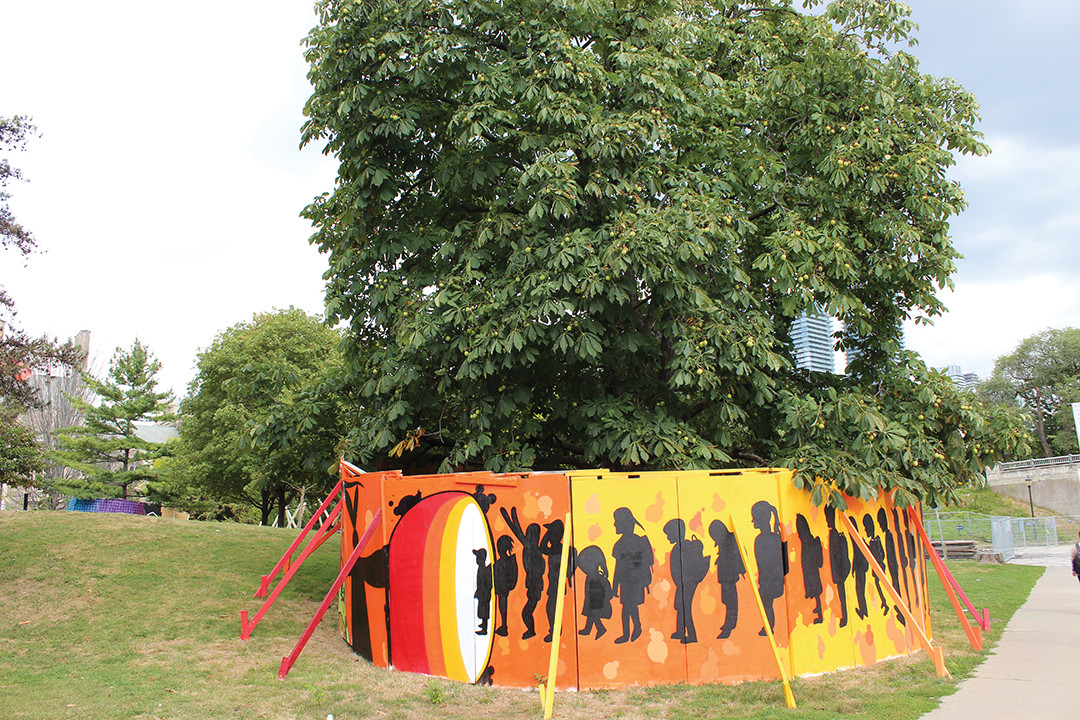As construction on the Landmark Project continues and the trees surrounding King’s College Circle and Hart House have been boarded up for protection, Hart House has taken advantage of these tree protection zones to showcase Indigenous artists.
A medley of street art and art centred around preserving the earth, the Tree Protection Zone (TPZ) is presented by eight Indigenous artists and supporting assistants.
The TPZ went on display on September 7 and will remain in place until the spring or summer of 2022 when the Indigenous Landscape Project begins. The Indigenous Landscape Project is planned for the Hart House Green and will more permanently pay tribute to Taddle Creek, on top of which Hart House is built.
This project was made in collaboration with the Office of the Vice-President, Operations and Real Estate Partnerships, University of Toronto; the Art Museum at the University of Toronto; Hart House; the Indigenous Student Services; and the Office of Indigenous Initiatives at U of T. Additional project support is provided by the City of Toronto’s Arts and Culture grant, the Ministry of Colleges and Universities, and U of T’s Postsecondary Education Fund for Aboriginal Learners.
Mikinaak (Mik) Migwans, co-curator of the TPZ, and Susan Blight, an artist of the Anishinaabe, Couchiching First Nation, shared their process and talked about their involvement in this project in an interview with The Varsity.
Creative ways of making Indigenous presence possible
Migwans sought creative ways to make Indigenous presence known in spaces that it was previously excluded from. They see the Indigenous artist-led interventions in public spaces as an important acknowledgement of the struggles of Indigenous peoples.
The chosen theme for the project was street art, which Blight shared was chosen because interventions are “a really important aspect to our resistance movements right now.” She said that “it’s important for Indigenous artists to get familiar with those techniques.”
Migwans and co-curator Maria Hupfield selected artists from varied art backgrounds for the project. While some were already familiar with street art techniques such as ‘weed pasting’ and aerosol, others sought to become more familiar with the techniques for the project.
Migwans shared that one artist they were particularly proud of was the basket maker Carrie Hill, who shifted to working in a different style for the project. By selecting artists from artistic backgrounds, Migwans said, “it was a learning experience and experimental experience.”
6 kilometres and 8000 years long
Hart House is built on top of Taddle Creek, a buried stream that runs steadily through the city of Toronto, including the St. George campus, flowing under Hart House and Trinity College.
In an interview, Blight said that her artwork titled “6 kilometres and 8000 years long” honours this hidden waterway that up until recently, in light of its 8,000 year history, has “been paved over [and] covered up,” now existing as a “subterranean sewer for the city.”
Blight used the example of Taddle Creek to shed light on the histories that have been erased or obscured on a social and systemic level related to Taddle Creek. “As an Indigenous person… we have responsibilities and accountabilities to the land and to the waterways,” Blight shared, explaining her desire to provoke dialogue and questions about this city’s waterways and our treatment of them.
The artwork itself is composed of over 2,000 compostable stickers, a nod to methods of stickering linked to political activism and movements, as well as the personal aesthetics with which we adorn personal items like skateboards. Migwan and her friends treated each sticker they put up as an action of accountability, which was reinforced by their use of compostable stickers as a gentle addition to the earth and waterways.


